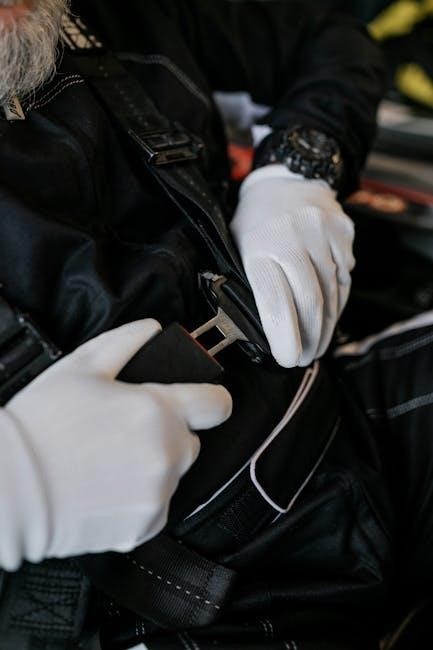The interactive grammar tutorial introduces the present tense of ser, a fundamental concept in Spanish grammar, with online lessons and exercises, including fill-in-the-blank activities and video tutorials, to help learners master the verb conjugation effectively always.
Overview of the Present Tense of Ser
The present tense of ser is a crucial aspect of Spanish grammar, used to describe permanent or inherent characteristics of a person, place, or thing.
The verb ser is conjugated differently depending on the subject, with forms such as soy, eres, es, somos, and son.
This overview provides a general understanding of the present tense of ser, including its usage and conjugation rules.
The interactive grammar tutorial offers a comprehensive introduction to the present tense of ser, covering its basic concepts and applications.
With online lessons and exercises, learners can gain a deeper understanding of the verb ser and its role in Spanish grammar.
The present tense of ser is used to describe a wide range of things, from physical characteristics to nationalities and professions.
By mastering the present tense of ser, learners can improve their overall Spanish language skills and communicate more effectively.
The tutorial’s interactive approach makes learning the present tense of ser engaging and fun, with quizzes, games, and other activities to reinforce understanding.
Overall, the present tense of ser is a fundamental concept in Spanish grammar, and this overview provides a solid foundation for further study and practice.
The interactive grammar tutorial is an excellent resource for learners of all levels, offering a comprehensive and engaging introduction to the present tense of ser.
Conjugation of Ser in the Present Tense
The verb ser conjugates as soy, eres, es, somos, sois, and son in the present tense, with each form used depending on the subject, as seen in online grammar tutorials and language learning resources always.
Forms of Ser Used in the Present Tense
The present tense of ser has six main forms, which are used to describe permanent or inherent characteristics of the subject. These forms include soy, eres, es, somos, sois, and son, each corresponding to a specific subject pronoun. The form soy is used with the subject yo, eres is used with tú, es is used with él, ella, or usted, somos is used with nosotros or nosotras, sois is used with vosotros or vosotras, and son is used with ellos, ellas, or ustedes. Understanding the correct usage of these forms is essential for effective communication in Spanish. Online resources, such as interactive grammar tutorials, provide practice exercises and quizzes to help learners master the present tense of ser. Additionally, language learning apps and websites offer conjugation charts, video lessons, and interactive games to reinforce learning. By practicing with these resources, learners can develop a strong foundation in the present tense of ser and improve their overall Spanish language skills. With consistent practice, learners can become proficient in using the correct forms of ser in context.
Subject Pronouns and Their Corresponding Forms of Ser
Subject pronouns like yo, tú, él, and nosotros correspond to specific ser forms, including soy, eres, es, and somos, used in interactive grammar tutorials to practice Spanish conjugation effectively always online.
Examples of Ser Conjugation in the Present Tense
The present tense of ser is used to describe permanent or inherent characteristics, and examples of its conjugation can be seen in sentences like “Yo soy estudiante” (I am a student) and “Ella es profesora” (She is a teacher).
Other examples include “Nosotros somos amigos” (We are friends) and “Ellos son estudiantes” (They are students), demonstrating the verb’s conjugation with different subject pronouns.
In interactive grammar tutorials, these examples are used to illustrate the correct usage of ser in the present tense, helping learners to understand and practice the verb’s conjugation in context.
Additionally, sentences like “La escuela es grande” (The school is big) and “El libro es interesante” (The book is interesting) show how ser is used to describe objects and their characteristics, further reinforcing the verb’s conjugation in the present tense.
By studying these examples, learners can gain a better understanding of how to use ser in the present tense and improve their Spanish language skills.
Overall, examples of ser conjugation in the present tense are essential for mastering the verb and communicating effectively in Spanish.
Translating Sentences Using the Present Tense of Ser
Translating sentences like “I am happy” to “Yo soy feliz” using the present tense of ser with online tools and exercises effectively always.
Common Mistakes to Avoid When Using the Present Tense of Ser
When using the present tense of ser, it is essential to avoid common mistakes that can alter the meaning of sentences. One of the most frequent errors is the incorrect use of ser conjugations, such as using “soy” instead of “es” or “somos” instead of “son”. This can lead to confusing and grammatically incorrect sentences. Another mistake is the failure to use the correct form of ser with different subject pronouns, such as “yo”, “tú”, “él”, “ella”, “usted”, “nosotros”, “vosotros”, “ellos”, and “ellas”. To avoid these mistakes, it is crucial to practice the conjugation of ser in the present tense and to review the rules for using the correct form of ser with different subject pronouns. Online resources and interactive grammar tutorials can provide valuable practice exercises and explanations to help learners master the present tense of ser and avoid common mistakes. By being aware of these potential mistakes, learners can improve their Spanish grammar skills and communicate more effectively. Effective practice and review are essential to achieving fluency in Spanish.
Practicing the Present Tense of Ser with Interactive Exercises
Interactive exercises, including quizzes and games, help learners practice the present tense of ser effectively online always with immediate feedback.
Tips for Mastering the Present Tense of Ser
To master the present tense of ser, it is essential to understand the different forms of the verb and how they are used in context. The internet provides a wealth of resources, including interactive grammar tutorials, videos, and practice exercises. Learners can benefit from using online tools, such as quizzes and games, to test their knowledge and identify areas for improvement. Additionally, studying the conjugation of ser in the present tense and practicing with sample sentences can help learners develop a deeper understanding of the verb. It is also important to learn the subject pronouns and their corresponding forms of ser, as this will help learners to use the verb correctly in different situations. By following these tips and practicing regularly, learners can master the present tense of ser and improve their overall Spanish language skills. With consistent practice and review, learners can become proficient in using the present tense of ser in their everyday conversations.
and Next Steps for Learning the Present Tense of Ser
Mastering the present tense of ser requires practice and review, with online resources and interactive tutorials providing a solid foundation for further learning and improvement always effectively every day.
Additional Resources for Further Practice and Review
For learners seeking to reinforce their understanding of the present tense of ser, numerous online resources are available, including interactive grammar tutorials, video lessons, and practice exercises. These resources can be accessed through various websites and language learning platforms, providing a comprehensive and engaging learning experience. Additionally, language exchange websites and forums offer opportunities for learners to practice their language skills with native speakers, receiving feedback and guidance on their use of the present tense of ser. Mobile apps, such as language learning apps, also provide a convenient and accessible way to review and practice the present tense of ser, with interactive lessons and exercises that can be completed at any time. By utilizing these resources, learners can solidify their grasp of the present tense of ser and continue to improve their overall Spanish language skills, ultimately achieving fluency and confidence in their ability to communicate effectively. Furthermore, these resources can be used in conjunction with traditional language learning methods, such as textbooks and classroom instruction, to create a well-rounded and supportive learning environment. Overall, the availability of these resources makes it easier for learners to achieve their language learning goals and master the present tense of ser.



Leave a Reply
You must be logged in to post a comment.